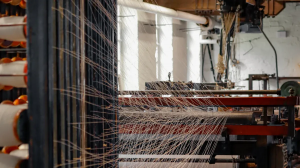You achieve the deepest, most authentic blue hues with the right fabric choice. For an indigo rope dyeing range, you should select heavyweight, 100% cotton twill.
Pro Tip: This fabric's natural cellulosic fibers, high absorbency, and durable structure make it the superior option for creating classic, deeply saturated denim.
● Choose heavyweight 100% cotton twill fabric. It absorbs indigo dye best for deep blue colors.
● Avoid synthetic fabrics like polyester and nylon. They do not absorb indigo dye well.
● Be careful with cotton blends. High amounts of elastane or other synthetics make the blue color lighter.

Selecting the right fabric is a critical decision for achieving your desired indigo shade. You have several excellent options, each offering unique characteristics. Your choice will directly influence the color depth, texture, and performance of the final product.
1. 100% Cotton: The Unrivaled Champion
You will find that 100% cotton is the gold standard for deep indigo dyeing. Its cellular structure is perfectly suited for absorbing and holding onto the indigo molecule. This natural fiber provides the most authentic and richest blue hues possible.
Key advantages you can expect from 100% cotton include:
● Superior Absorbency: Cotton fibers act like a sponge, readily soaking up the indigo dye during each dip in the vat.
● Exceptional Strength: The fabric withstands the high tension and repeated processing of an Indigo Rope Dyeing Range without compromising its integrity.
● Classic "Ring Dyeing" Effect: Using ring-spun cotton yarn allows the indigo to penetrate the outer layers while leaving the core white. This creates the signature fading characteristics that denim enthusiasts prize.
2. Cotton/Elastane Blends
You may consider a cotton blend with a small amount of elastane (often sold as Lycra® or Spandex®) for added comfort and stretch. While functional, this choice involves a trade-off. Elastane is a synthetic fiber and does not absorb indigo dye.
Note: The percentage of elastane directly impacts the final color. A higher elastane content means less cotton is available to bond with the dye, resulting in a noticeably lighter shade of blue.
You should carefully evaluate the blend composition based on your project goals.
| Elastane % | Expected Outcome |
|---|---|
| 1-2% | Provides comfort stretch with minimal impact on color depth. A good compromise. |
| 3-5% | Results in a significantly lighter blue. The stretch becomes a primary feature. |
| >5% | Not recommended for deep indigo dyeing. The color will appear washed out. |
These blends require careful handling in an Indigo Rope Dyeing Range, as the elasticity can affect tension control.
3. Cotton/Linen Blends
You can achieve a unique, vintage aesthetic by choosing a cotton/linen blend. Linen, another natural cellulosic fiber, interacts with indigo differently than cotton. It introduces a distinct texture and alters the final color profile, making it a fantastic choice for specific looks.
The addition of linen creates several desirable effects:
● It introduces a "slubby" or irregular texture to the fabric's surface.
● It often results in a perfect medium blue shade rather than a deep, dark indigo.
● The fabric develops a beautiful drape and character that improves with each wash.
● Many find the lighter color and texture ideal for creating summer-weight garments.
However, you must properly prepare these blends before dyeing. Both cotton and linen have natural waxes and pectins that can prevent the indigo from adhering to the fibers. Inadequate scouring is a primary cause of uneven dyeing and poor colorfastness.
To ensure success, you must follow a strict pre-treatment process:
1.Scour the Fabric: You need to boil the fabric with soda ash for several hours. This crucial step strips away any coatings or natural impurities that block dye absorption.
2.Rinse Thoroughly: After scouring, you must rinse the material completely to remove all scouring agents.
3.Consider a Soy Milk Treatment: Applying a thin layer of soy milk can act as a binder. This protein "glazing" helps the indigo adhere better and protects the fabric from fading due to rubbing or UV exposure.
You must understand a fabric's core characteristics to predict its performance in a dye range. Fiber type, weight, and weave structure are the three pillars that determine the final color depth and texture of your indigo-dyed material.
Fiber Type: Why Cellulose is Essential
You will achieve the best results with cellulosic fibers like cotton. The molecular structure of cellulose is porous and features numerous hydroxyl groups on its surface. This structure makes the fiber highly absorbent, allowing it to readily take in the dye. In contrast, synthetic fibers are hydrophobic (water-repelling) and resist water-soluble dyes.
The indigo dyeing process relies on a specific chemical reaction with cellulose:
1.You first reduce insoluble indigo into a soluble, greenish-yellow form called leuco-indigo.
2.The cotton fibers then adsorb this soluble dye through physical forces.
3.You then expose the dyed material to air, which oxidizes the leuco-indigo.
4.This final step locks the now-insoluble blue pigment inside the fibers, creating a wash-fast color.
Fabric Weight and Density
You should choose a heavier, denser fabric for the deepest blues. A higher fabric weight means there is more cotton fiber per square inch. This increased mass provides a greater surface area and more material to absorb the indigo dye during each dip. Lighter fabrics simply cannot hold enough dye to achieve a dark, saturated shade.
Pro Tip: Heavier denim (12 oz. and above) is ideal because its dense construction maximizes dye uptake, leading to the rich, dark indigo hues that define premium raw denim.
Weave Structure and Its Impact
You will find that the fabric's weave directly influences its texture and appearance. While a 3x1 right-hand twill is the standard for classic denim, other weaves offer unique visual effects. You can select a different weave to add character to your final product.
● Crosshatch/Herringbone: This weave creates a distinct fishbone pattern. It adds texture and visual depth, offering a modern alternative to traditional twill.
● Dobby Weave: You can use this weave to produce small, geometric patterns. It gives the denim surface a unique texture, perfect for contemporary garments.
● Jacquard Weave: For highly intricate designs, you can use a jacquard loom. This method allows you to weave complex patterns, like florals or motifs, directly into the denim.

You must evaluate a fabric's suitability for the mechanical demands of the dyeing process. The journey through an Indigo Rope Dyeing Range is intense. Your fabric choice determines whether you achieve a flawless, deep blue or encounter costly defects.
Why Heavyweight Fabrics Excel
You will find that heavyweight fabrics consistently produce the best results. A heavier fabric, like a 14 oz. denim, contains more cotton fibers in a dense structure. This density provides a larger surface area for the indigo to adhere to during each dip. The fabric can absorb and hold more dye, which is essential for achieving the deep, saturated blues that define premium raw denim. Lighter fabrics simply lack the mass to build up such a rich color.
Tension and Durability Requirements
You need a fabric that can withstand significant physical stress. The machinery pulls the fabric ropes through multiple dye vats and rollers under high tension. A weak or poorly constructed fabric will fail.
Caution: Mechanical friction is a primary cause of defects. You should watch for signs of damage.
Common points of failure you might see include:
● Dyeing abrasion: White shining on the fabric surface from rubbing.
● Rope rub marks: Shiny spots caused by friction between ropes.
● White creases: Long, shiny lines where the fabric was folded under pressure.
● Crease marks: Permanent deformations that occur when the fabric passes through squeeze rollers, often due to poor fabric quality or incorrect machine loading.
Choosing a durable, high-quality fabric is your best defense against these issues.
How Weave Affects Dye Uptake
You should understand how a fabric's weave influences dye absorption. A 3x1 twill weave, standard for denim, creates distinct diagonal lines. These ridges and valleys affect how the dye settles on the yarn. The raised parts of the weave may absorb dye differently than the recessed parts, enhancing the fabric's texture and contributing to the unique fading patterns of denim over time. This structure allows for the classic "ring dyeing" effect, where the yarn's core remains white while the exterior turns a deep blue.
You must select the right material for successful dyeing. Certain fabrics are fundamentally incompatible with the indigo rope dyeing process. You should avoid them to prevent poor results and potential damage to your materials.
Purely Synthetic Fabrics
You will find that purely synthetic fabrics like polyester and nylon are unsuitable for indigo dyeing. Polyester is hydrophobic, meaning it repels water. Its crystalline structure resists water-soluble dyes, preventing the indigo from bonding effectively. You will see the dye simply wash away, leaving the fabric mostly uncolored. These materials lack the necessary chemical structure to form a lasting bond with the indigo pigment.
Protein Fibers (Wool and Silk)
You should not use protein-based fibers like wool and silk in a traditional indigo vat. The dyeing process requires a highly alkaline (high pH) environment. These conditions cause significant chemical damage to protein fibers.
Warning: The alkaline fluid in an indigo vat can ruin the texture and appearance of wool and silk.
You can expect the following types of damage:
● A noticeable loss of the fiber's natural luster and shine.
● The fabric becomes stiff and loses its smooth, flexible drape.
● The texture can degrade, becoming rough and "cottony" to the touch.
High-Percentage Synthetic Blends
You should also avoid cotton blends with a high percentage of synthetic fibers. When you dye these fabrics, only the cotton fibers absorb the indigo. The synthetic fibers, like polyester, remain white. This creates an uneven, mottled appearance known as a "heather" effect. You may see this undesirable result in blends with as little as 10% polyester. For a solid, deep blue, you must use fabrics with minimal to no synthetic content.
You will achieve the most authentic and durable results with heavyweight 100% cotton twill. While blends with minimal stretch are viable, you should understand the trade-offs in longevity.
| Feature | 100% Cotton Jeans | Cotton/Elastane Blend Jeans |
|---|---|---|
| Structural Integrity | More predictable for multi-year usage | Elastane fibers degrade; elasticity loss can occur within 8 months |
| Tensile Strength | Retains better over long-term washing | Declines as elastane's ability to 'bounce back' weakens |
| Observed Lifespan | Favored for long-term wear and aging | May last fewer seasons; returns often cited for elasticity loss |
You must select the right fabric for your Indigo Rope Dyeing Range to achieve professional-grade, deeply saturated denim.
What is the absolute best fabric for deep indigo dyeing?
You should choose heavyweight, 100% cotton twill. It offers the best dye absorption and durability, ensuring the deepest and most authentic blue hues for your project.
Can you use stretch denim for rope dyeing?
You can use blends with 1-2% elastane. This amount adds comfort stretch with minimal impact on color. Higher percentages will result in a significantly lighter shade of blue.
What is the minimum fabric weight for good results?
You should select fabrics weighing 12 oz. or more. Heavier materials have more fiber mass to absorb dye, which is necessary for achieving a rich, dark indigo color.
Post time: Oct-31-2025
